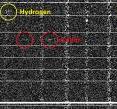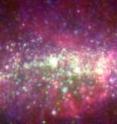Making the invisible visible
This release is available in German.
The Large Binocular Telescope (LBT) partners in Germany, the U.S.A. and Italy are pleased to announce that the first of two new innovative near-infrared cameras/spectrographs for the LBT is now available to astronomers for scientific observations at the telescope on Mt. Graham in south-eastern Arizona. After more than a decade of design, manufacturing and testing, the new instrument, dubbed LUCIFER 1, provides a powerful tool to gain spectacular insights into the universe, from the Milky Way up to extremely distant galaxies. LUCIFER 1 has been built by a consortium of German institutes and will be followed by an identical twin instrument that will be delivered to the telescope in early 2011.
LUCIFER's innovative design allows astronomers to observe in unprecedented detail, for example, star forming regions which are commonly hidden by dust clouds. The instrument provides unrivaled flexibility, with features such as a unique robotic arm that can replace spectroscopic masks within the instrument's extreme sub-zero environment.
LUCIFER and its twin are mounted at the focus points of the LBT's two giant 8.4-metre (27.6 foot) diameter telescope mirrors. Each instrument is cooled to a chilly -213 degrees Celsius in order to observe in the near-infrared (NIR) wavelength range. Near-infrared observations are essential for understanding the formation of stars and planets in our galaxy as well as revealing the secrets of the most distant and very young galaxies.
LUCIFER is a remarkable new multi-purpose instrument with great flexibility combining a large field of view with a high resolution. It provides three exchangeable cameras for imaging and spectroscopy in different resolutions according to observational requirements. Besides its outstanding imaging capability which presently makes use of 18 high-quality filters, LUCIFER allows the simultaneous spectroscopy of about two dozen objects in the infrared through laser-cut slit-masks. For highest flexibility the masks can be changed even at the cryogenic temperatures, through the innovative development of a unique robotic mask grabber which places the individual masks with absolute precision into the focal plane.
"Together with the large light gathering power of the LBT, astronomers are now able to collect the spectral fingerprints of the faintest and most distant objects in the universe." says Richard Green, the Director of the LBT. "After completion of the LBT adaptive secondary mirror system to correct for atmospheric perturbation, LUCIFER will show its full capability by delivering images with a quality that are otherwise only obtained from space-based observatories."
"Already the very first LUCIFER observations of star forming regions are giving us an indication of the enormous potential of the new instrument," said Thomas Henning, the chair of the German LBT-Partners.
The instruments have been built by a consortium of five German institutes led by the Center for Astronomy of Heidelberg University (Landessternwarte Heidelberg, LSW) together with the Max Planck Institute for Astronomy in Heidelberg (MPIA), the Max Planck Institute for Extraterrestrial Physics in Garching (MPE), the Astronomical Institute of the Ruhr-University in Bochum (AIRUB) as well as the University of Applied Sciences in Mannheim (Hochschule Mannheim).
Walter Seifert (LSW), Nancy Ageorges (MPE) and Marcus Jütte (AIRUB), responsible for the successful commissioning, spent more than half a year in several runs at the LBT site to make the telescope/instrument combination work efficiently. Holger Mandel, the Principal Investigator of LUCIFER said: "From the very beginning, there was uniform excitement about the promise of this instrument for cutting-edge science. Now, the amazing results speak for themselves."
Source: Max-Planck-Gesellschaft
Articles on the same topic
- LUCIFER allows astronomers to watch stars being bornThu, 22 Apr 2010, 21:30:14 UTC
Other sources
- Astronomers watch stars being bornfrom UPIMon, 26 Apr 2010, 17:32:20 UTC
- New near-infrared cameras/spectrographs for the Large Binocular Telescopefrom Science DailyThu, 22 Apr 2010, 16:36:10 UTC
- Making the invisible visible: New workhorse for the world`s largest optical telescopefrom PhysorgWed, 21 Apr 2010, 22:31:00 UTC

